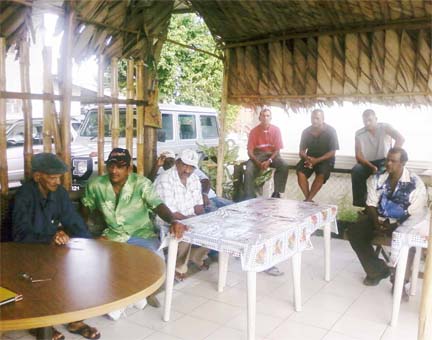At 81, all Jaieshwar Persaud knows is rice farming. He has farmed the land since his early teenage years and it has provided for him. This year the water shortage resulting from the current El Nino conditions has burnt up Persaud’s 10 acres of rice.

Like many farmers, the land has failed to provide for Persaud this crop. He has nothing left to harvest and no other source of income. Persaud is doubtful that he will be able to replant his Windsor Forest land for the second crop this year.
“Not even a pint I don’t have left in the field to cut,” the distressed and angry man told Stabroek News yesterday. “Everything is gone.”
What next? This is the question Persaud asks himself daily. This is the question on the mind of other small scale farmers who have already lost or are on their way to losing their acres of paddy.
“Since I was 15 I’ve been planting rice,” Persaud stated. “I don’t think I can remember a situation as bad as this.”
At Blankenburg, Ruim-zeight, Waller’s Delight, La Jalousie, Crane, Zeeburg and Ruby the situation is the same. More and more farmers are beginning to cry out about water woes and they believe that poor management by the relevant authorities has resulted in the current problem.
During a meeting yesterday at Alesie Rice, Ruim-zeight farmers raised several issues. They reported that despite interventions which the Ministry of Agriculture (MoA) and the National Drainage and Irrigation Authority (NDIA) have taken they are still not able to access water. Works which the Guyana Rice Producers’ Association (GRPA) has reportedly embarked on to clear main distributaries and their embankments are not being done, farmers said. They further said that despite the fact that rice prices are inching up, the paddy price remains the same.
NDIA Corporate Secretary Omadatt Chandan in a letter to this newspaper published on February 17 (in response to a letter by Charles Sohan on February 13) listed interventions which were being made by the authority to address the current water shortage.
This is what Chandan said with regard to the situation in Region Three: “In Region Three, a decision was taken to pump water from the Bonasika River to the Boerasirie Conservancy to ensure there were adequate amounts of irrigation water. Water is then being pumped to Ruby and Centreline to ensure that those farming communities have adequate water. Irrigator pumps have been installed in key, vulnerable areas as well. Further, the ministry through its outreach programme has been interacting and providing support to farmers. In addition, holding ponds are being excavated at Leguan.”
Chandan further said, “Also, some $3.2M is being spent daily for the operations of 23 irrigation pumps in Regions Two, Three, Four, Five, Six and Ten. A taskforce was formed last year when these conditions continued to make necessary interventions in the vulnerable communities around the country.”
Despite the Corporate Secretary’s report, farmers yesterday said that only one pump is currently in operation and there is always a shortage of fuel. They further pointed out that the water which is being pumped is being used up by GuySuCo’s Uitvlugt Estate before they can access it.
Currently, GuySuCo has four kokers open, they reported, when they had promised that they would only open one.
“Cane is getting first preference to the water,” Mangal Mathura stated. “The cane will not die if it does not get enough water at this point but our rice will die.”
Mathura farms 40 acres at Zeeburg and another 20 acres at Crane.
Narine Ganpat farms six acres at La Jalousie; G. Singh has 25 acres between that location and Waller’s Delight and R. Singh 25 acres. These men pointed out that before anything was done to help them they had to “run” to the relevant authorities for more than two weeks. They further pointed out that the embankment which the GRPA is supposed to be clearing is still in the same state.
“It was we that had to clear a part of that embankment hoping that the water would come back this side,” R. Singh said.
R. Doma who farms 70 acres at La Jalousie, Dilinie Bisaul who has 30 acres at Ruby, Anil Beharry, Takelall, N. Jato, S. Mareej and R. Sudama also voiced similar complaints.
Meanwhile, the chairperson at the meeting, Jinnah Rahaman and another farmer Saleem Abdool both felt that the MoA had sufficient resources to foretell the current conditions and should have been able to take steps far earlier than they did.
Rahaman said that since last May the Minister of Agriculture Robert Persaud had announced that he was aware of the coming El Nino condition and said last August that steps were being taken to prepare for it. Have they dealt with it? Have they prepared for it? These are questions Rahaman urged farmers to ask themselves.
There is no water in the fields, Rahaman said, reiterating what all the farmers stressed. He further noted that rice production is costly for small scale farmers and the only reasons farmers have never felt the pressure so much before is because they had cash crops and poultry to depend on.
Farmers insist that to date MoA has not given them advice worth listening to. Some believe they could have been forewarned not to cultivate the amounts they did. In just 10 days, if it doesn’t rain or farmers aren’t able to access enough water for their crops then hundreds of acres will be lost to El Nino.
Many will have no source of income for the first half of this year and this will have a devastating impact on their lives.
“We have families to feed and children to educate, we have needs like every other citizen in this country and rice is how we get it,” one farmer stated.
Just over a decade ago the rice industry was severely affected by extreme El Nino conditions.
During this 1998 El Nino phenomenon Region Three farmers were heavily affected. As a result paddy prices went from $2,200 per bag in late 1997 to $2,600 by mid January 1998.
This time around it does not appear as though there will be any improvement for the second crop. If these small scale farmers lose their first crops then they will not be able to afford to replant for the second crop. As for the prices being improved, the farmers don’t believe they benefit from this increase.
Recently, white and brown rice prices have increased by $80 and $60, respectively. If these El Nino conditions continue it is expected that prices will climb higher. Despite this high possibility of the increase in rice price farmers are not confident that they will get more for whatever paddy they manage to save. Currently they are being paid between $2,200 and $3,000 per bag of paddy.








